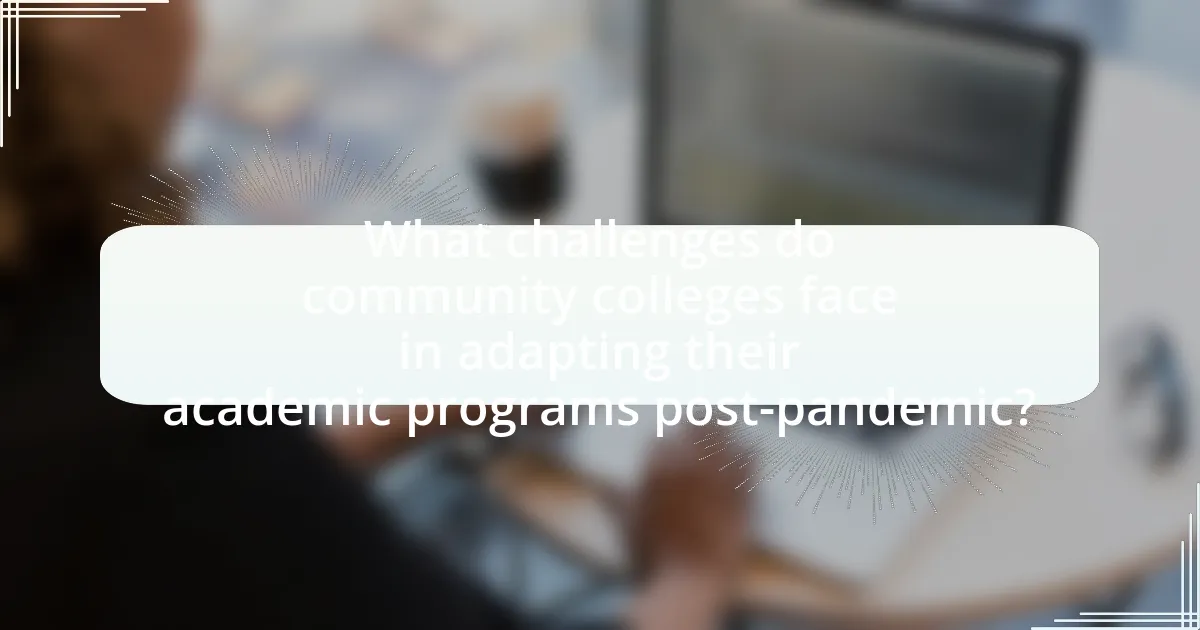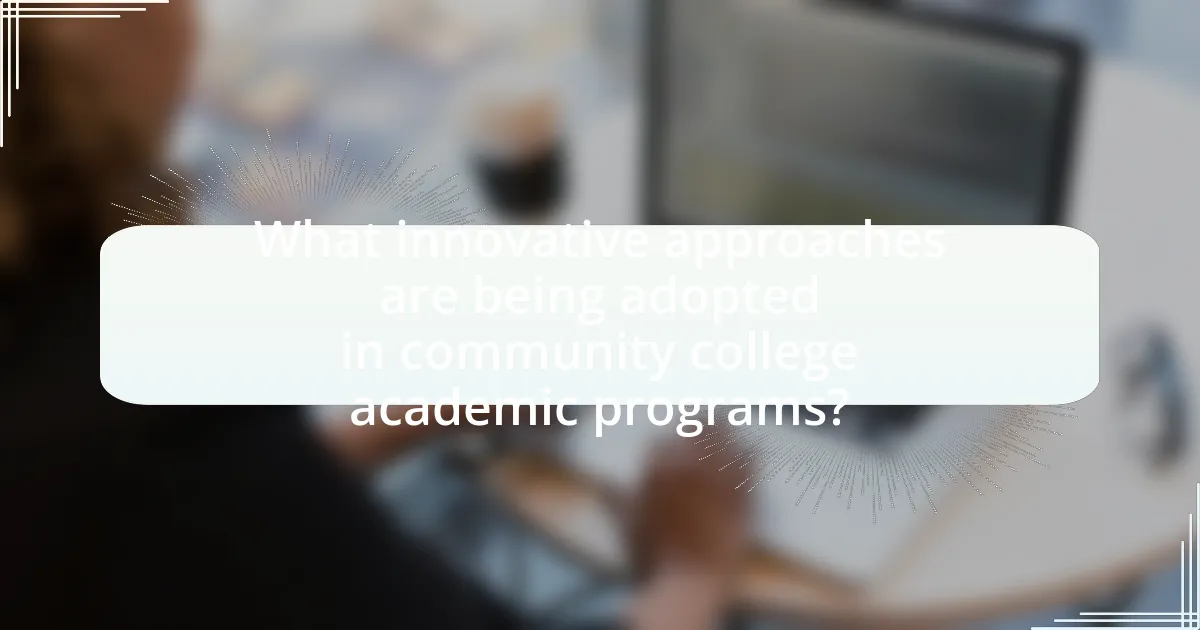The article examines the future of community college academic programs in a post-pandemic world, highlighting key trends such as the rise of online learning, a focus on workforce development, and enhanced student support services. It discusses how the pandemic has influenced enrollment patterns, demographic shifts, and changing student needs, emphasizing the importance of technology in education. Additionally, the article addresses the challenges community colleges face, including financial constraints and the need for program alignment with local job markets, while exploring innovative approaches and partnerships that enhance student employability and address societal needs.

What are the key trends shaping the future of community college academic programs in a post-pandemic world?
Key trends shaping the future of community college academic programs in a post-pandemic world include increased online learning, a focus on workforce development, and enhanced support services for students. The shift to online learning has accelerated due to the pandemic, with many colleges adopting hybrid models that combine in-person and virtual instruction, allowing for greater flexibility and accessibility. Workforce development has become a priority as community colleges align their programs with local labor market needs, offering courses in high-demand fields such as healthcare, technology, and skilled trades. Additionally, enhanced support services, including mental health resources and academic advising, are being implemented to address the challenges students face in a post-pandemic environment, ensuring they have the necessary support to succeed. These trends reflect a responsive approach to evolving educational demands and economic conditions.
How has the pandemic influenced enrollment patterns in community colleges?
The pandemic has significantly influenced enrollment patterns in community colleges by causing a decline in overall enrollment numbers. According to the National Student Clearinghouse Research Center, community college enrollment dropped by 9.5% in the fall of 2020 compared to the previous year, reflecting a trend of students opting for immediate workforce entry or deferring their education due to economic uncertainties. Additionally, the shift to online learning led to increased challenges for many students, particularly those from disadvantaged backgrounds, further impacting their decision to enroll.
What demographic shifts are affecting community college enrollment?
Demographic shifts affecting community college enrollment include an increase in adult learners, a decline in traditional college-age students, and growing diversity among the student population. Adult learners, often seeking to upskill or change careers, have become a significant portion of community college enrollment, with the National Center for Education Statistics reporting that nearly 40% of community college students are over the age of 25. Concurrently, the number of high school graduates is projected to decline in many regions, leading to fewer traditional students entering community colleges. Additionally, community colleges are seeing increased enrollment from diverse racial and ethnic groups, reflecting broader societal changes; for instance, Hispanic students represented 29% of community college enrollment in 2020, according to the American Association of Community Colleges. These shifts indicate a transformation in the demographic landscape of community college students, influencing program offerings and institutional strategies.
How have student needs changed in the wake of the pandemic?
Student needs have shifted significantly in the wake of the pandemic, with increased demand for flexible learning options and mental health support. Research indicates that many students now prioritize online and hybrid course formats due to the convenience and accessibility they offer, as evidenced by a survey from the National Student Clearinghouse, which found that enrollment in online courses surged by 93% during the pandemic. Additionally, there is a heightened awareness of mental health issues, leading to a greater need for counseling services and resources, as reported by the American College Health Association, which noted a 30% increase in students seeking mental health support. These changes reflect a broader trend towards accommodating diverse learning preferences and addressing the emotional well-being of students in educational settings.
What role does technology play in the evolution of community college programs?
Technology plays a crucial role in the evolution of community college programs by enhancing accessibility, flexibility, and the quality of education. The integration of online learning platforms and digital resources allows students to access courses remotely, accommodating diverse schedules and learning styles. For instance, a report from the National Center for Education Statistics indicates that over 30% of community college students enrolled in at least one online course in 2020, reflecting a significant shift towards digital education. Additionally, technology facilitates the development of innovative teaching methods, such as blended learning and interactive simulations, which improve student engagement and retention rates. This evolution is essential for community colleges to meet the changing demands of the workforce and provide relevant skills training in a rapidly advancing technological landscape.
How are online learning platforms being integrated into community college curricula?
Online learning platforms are being integrated into community college curricula through hybrid course models that combine traditional in-person instruction with online components. This integration allows for greater flexibility in course delivery, enabling students to access materials and complete assignments remotely. According to a report by the National Center for Education Statistics, over 70% of community colleges have adopted online learning tools to enhance educational offerings, reflecting a significant shift towards digital learning environments in response to the increased demand for accessible education during and after the pandemic.
What technological tools are enhancing student engagement and learning outcomes?
Technological tools enhancing student engagement and learning outcomes include learning management systems (LMS), interactive multimedia, and gamification platforms. Learning management systems like Canvas and Blackboard facilitate communication, resource sharing, and assessment tracking, which have been shown to improve student participation and performance. Interactive multimedia tools, such as videos and simulations, cater to diverse learning styles and have been linked to increased retention rates. Gamification platforms, which incorporate game-like elements into learning, have demonstrated effectiveness in motivating students and enhancing their overall learning experience. Studies indicate that these tools contribute to higher engagement levels and improved academic results, making them essential in modern educational environments.
What are the implications of workforce demands on community college offerings?
Workforce demands significantly influence community college offerings by necessitating the development of programs that align with current job market needs. As industries evolve, community colleges adapt their curricula to provide relevant skills and training, ensuring graduates are employable in high-demand fields such as healthcare, technology, and skilled trades. For instance, the U.S. Bureau of Labor Statistics projects that healthcare occupations will grow by 15% from 2019 to 2029, prompting community colleges to expand nursing and allied health programs to meet this demand. Additionally, the rise of remote work and digital skills has led to increased offerings in information technology and online learning platforms, reflecting the shift in workforce requirements.
Which industries are driving changes in community college program development?
Healthcare, technology, and skilled trades are the primary industries driving changes in community college program development. The healthcare sector demands a growing workforce due to an aging population and increased healthcare needs, prompting community colleges to expand programs in nursing, allied health, and health information technology. The technology industry, particularly in areas like cybersecurity, data analytics, and software development, is influencing curriculum updates to meet the skills gap in the labor market. Additionally, the skilled trades sector, including construction and manufacturing, is seeing a resurgence, leading community colleges to enhance vocational training programs to prepare students for high-demand jobs. These shifts are supported by workforce data indicating significant job growth in these fields, necessitating a responsive educational framework.
How can community colleges align their programs with local job market needs?
Community colleges can align their programs with local job market needs by conducting regular labor market assessments to identify in-demand skills and occupations. This approach allows institutions to tailor curricula and training programs to meet the specific requirements of local employers. For instance, a report from the Georgetown University Center on Education and the Workforce indicates that 65% of jobs will require postsecondary education by 2020, emphasizing the need for community colleges to adapt their offerings accordingly. Additionally, partnerships with local businesses and industry leaders can facilitate the development of relevant programs and internships, ensuring that students gain practical experience that aligns with current job market demands.

What challenges do community colleges face in adapting their academic programs post-pandemic?
Community colleges face significant challenges in adapting their academic programs post-pandemic, primarily due to shifts in student enrollment patterns and the need for updated curriculum to meet evolving job market demands. Enrollment has declined in many community colleges, with a 10% drop reported by the National Student Clearinghouse Research Center in 2021, leading to reduced funding and resources for program development. Additionally, the rapid advancement of technology and changes in workforce requirements necessitate a reevaluation of existing programs to ensure they align with current industry standards. This includes integrating online learning modalities and enhancing support services for students who may be struggling with the transition back to in-person education.
How are funding and resource allocation impacting program development?
Funding and resource allocation significantly impact program development by determining the availability of financial and material support for educational initiatives. Adequate funding enables community colleges to develop and enhance academic programs, hire qualified faculty, and invest in necessary technology and infrastructure. For instance, a report from the American Association of Community Colleges indicates that institutions with stable funding sources are more likely to innovate and expand their program offerings, thereby meeting the evolving needs of students and the workforce. Conversely, insufficient funding can lead to program cuts, reduced course offerings, and limited access to resources, ultimately hindering the quality of education provided.
What financial challenges are community colleges experiencing currently?
Community colleges are currently facing significant financial challenges, primarily due to declining enrollment and reduced state funding. Enrollment in community colleges has decreased by approximately 10% since the onset of the COVID-19 pandemic, leading to lower tuition revenue. Additionally, many states have cut funding for higher education, with a report from the Center on Budget and Policy Priorities indicating that state funding for public colleges and universities is still below pre-pandemic levels in many areas. These factors contribute to budget shortfalls, limiting resources for academic programs and student support services.
How can community colleges secure funding for new program initiatives?
Community colleges can secure funding for new program initiatives through a combination of federal and state grants, partnerships with local businesses, and fundraising efforts. Federal programs such as the Strengthening Institutions Program provide financial support specifically for community colleges to enhance their academic offerings. Additionally, state governments often allocate funds for workforce development initiatives that align with local economic needs. Collaborating with local businesses can lead to sponsorships or in-kind contributions, which can further support program development. Fundraising campaigns targeting alumni and community members can also generate necessary resources for new initiatives.
What barriers exist for students returning to community college?
Barriers for students returning to community college include financial constraints, lack of support services, and challenges related to balancing work and family responsibilities. Financial constraints often manifest as insufficient funds for tuition, fees, and related expenses, which can deter enrollment; for instance, a report from the National Center for Education Statistics indicates that nearly 40% of community college students work full-time, limiting their ability to afford education. Lack of support services, such as academic advising and mental health resources, can hinder students’ ability to navigate their educational paths effectively. Additionally, the struggle to balance work and family responsibilities can create significant obstacles, as many returning students juggle multiple commitments, making it difficult to prioritize their education.
How do mental health and wellness issues affect student retention?
Mental health and wellness issues significantly impact student retention by leading to increased dropout rates among affected individuals. Research indicates that students experiencing mental health challenges, such as anxiety and depression, are more likely to withdraw from their academic programs. For instance, a study published in the Journal of College Student Development found that 30% of students with mental health issues reported considering leaving college due to their struggles. Furthermore, institutions that provide mental health resources and support systems see improved retention rates, as students are more likely to persist when they feel supported. This correlation underscores the necessity for community colleges to prioritize mental health services to enhance student retention in a post-pandemic educational landscape.
What support systems can be implemented to assist returning students?
Support systems that can be implemented to assist returning students include academic advising, mental health services, and flexible scheduling options. Academic advising provides personalized guidance to help students navigate their educational paths, ensuring they select appropriate courses and understand degree requirements. Mental health services offer counseling and support to address the emotional challenges that returning students may face, which is crucial given that studies indicate a rise in mental health issues among students post-pandemic. Flexible scheduling options, such as evening or online classes, accommodate the diverse needs of returning students, allowing them to balance education with work and family responsibilities. These systems collectively enhance the likelihood of student success and retention in community college programs.
How can community colleges ensure equity and access in their programs?
Community colleges can ensure equity and access in their programs by implementing targeted outreach initiatives and providing comprehensive support services. These institutions can actively engage underrepresented communities through partnerships with local organizations, which helps to raise awareness about available programs and resources. Additionally, offering financial aid options, such as scholarships and grants, can alleviate economic barriers that prevent access to education.
Research indicates that community colleges that adopt holistic support systems, including academic advising, tutoring, and mental health services, see improved retention and completion rates among diverse student populations. For example, a study by the American Association of Community Colleges found that institutions with robust support services increased student success rates by up to 20%. By focusing on these strategies, community colleges can create a more equitable educational environment that meets the needs of all students.
What strategies can be employed to reach underserved populations?
To reach underserved populations, community colleges can implement targeted outreach programs, establish partnerships with local organizations, and offer flexible course schedules. Targeted outreach programs, such as community workshops and informational sessions, can raise awareness about available academic programs. Partnerships with local organizations, including non-profits and community groups, can facilitate access to resources and support for potential students. Additionally, offering flexible course schedules, including evening and online classes, accommodates the diverse needs of underserved populations, allowing them to balance education with work and family commitments. These strategies are supported by research indicating that community engagement and accessibility significantly improve enrollment and retention rates among underserved groups.
How can community colleges address the digital divide among students?
Community colleges can address the digital divide among students by providing affordable access to technology and internet resources. Many community colleges have implemented programs that offer free or low-cost laptops and Wi-Fi hotspots to students in need, which directly supports their ability to participate in online learning. For instance, a study by the National Center for Education Statistics found that 14% of community college students reported not having reliable internet access, highlighting the need for targeted interventions. Additionally, community colleges can offer digital literacy training to ensure that all students are equipped with the necessary skills to navigate online platforms effectively. By combining access to technology with training, community colleges can significantly reduce the digital divide and enhance educational equity.

What innovative approaches are being adopted in community college academic programs?
Community colleges are adopting innovative approaches such as hybrid learning models, competency-based education, and partnerships with local industries. Hybrid learning combines online and in-person instruction, allowing flexibility and accessibility for students, which has become essential in the post-pandemic landscape. Competency-based education focuses on students mastering skills at their own pace, promoting personalized learning experiences. Additionally, partnerships with local industries ensure that academic programs align with workforce needs, enhancing job readiness for graduates. These approaches are supported by data indicating that community colleges implementing such strategies have seen increased enrollment and improved student outcomes.
How are community colleges incorporating experiential learning opportunities?
Community colleges are incorporating experiential learning opportunities by integrating hands-on projects, internships, and community service into their curricula. These institutions recognize the importance of practical experience in enhancing student engagement and employability. For instance, many community colleges have established partnerships with local businesses and organizations to provide students with real-world work experiences, which has been shown to improve job readiness. According to a report from the American Association of Community Colleges, over 70% of community colleges now offer some form of experiential learning, reflecting a significant shift towards applied education in response to the evolving job market.
What types of partnerships are being formed with local businesses and organizations?
Community colleges are forming partnerships with local businesses and organizations primarily in the areas of workforce development, internship programs, and curriculum alignment. These collaborations aim to ensure that academic programs are tailored to meet the specific skills and needs of the local job market. For instance, partnerships with technology firms often lead to the development of specialized training programs that equip students with in-demand technical skills, thereby enhancing employability. Additionally, local businesses may provide internship opportunities that allow students to gain practical experience while still enrolled in their academic programs, fostering a direct link between education and employment.
How do internships and co-op programs enhance student employability?
Internships and co-op programs significantly enhance student employability by providing practical experience and industry exposure. These programs allow students to apply theoretical knowledge in real-world settings, which employers highly value. According to a survey by the National Association of Colleges and Employers, 70% of employers prefer candidates with internship experience, as it demonstrates relevant skills and a proactive approach to career development. Additionally, internships and co-ops often lead to networking opportunities, increasing the likelihood of job offers post-graduation.
What new program areas are emerging in response to societal needs?
New program areas emerging in response to societal needs include mental health services, digital literacy, and workforce development in technology and healthcare. Community colleges are increasingly offering programs that address the growing demand for mental health professionals, as evidenced by a 2021 report from the National Council for Mental Wellbeing, which highlighted a significant increase in mental health issues during the pandemic. Additionally, the rise of remote work has led to a surge in digital literacy programs, with the U.S. Bureau of Labor Statistics projecting a 13% growth in computer and information technology jobs from 2020 to 2030. Furthermore, healthcare programs are expanding to meet the urgent need for skilled workers, particularly in nursing and allied health fields, as reported by the American Association of Colleges of Nursing, which noted a critical shortage of nurses exacerbated by the pandemic.
How are community colleges addressing issues like sustainability and public health?
Community colleges are addressing issues like sustainability and public health by integrating relevant curricula and community initiatives. For instance, many institutions have developed programs focused on environmental science, public health education, and sustainable practices, which equip students with the skills needed to tackle these pressing challenges. According to the American Association of Community Colleges, over 60% of community colleges have implemented sustainability initiatives, such as energy-efficient campus operations and partnerships with local health organizations to promote public health awareness. These efforts not only enhance educational offerings but also foster community engagement and support local economies.
What role do soft skills play in the development of new academic programs?
Soft skills are essential in the development of new academic programs as they enhance students’ employability and adaptability in a rapidly changing job market. Academic programs that integrate soft skills training, such as communication, teamwork, and problem-solving, prepare students for real-world challenges and improve their ability to collaborate effectively in diverse environments. Research by the National Association of Colleges and Employers indicates that 93% of employers prioritize soft skills in hiring decisions, underscoring the necessity for academic programs to incorporate these competencies to meet industry demands and ensure student success.
What best practices can community colleges adopt for program evaluation and improvement?
Community colleges can adopt data-driven assessment as a best practice for program evaluation and improvement. This involves systematically collecting and analyzing data on student outcomes, enrollment trends, and program effectiveness to inform decision-making. For instance, a study by the Community College Research Center found that colleges that utilized data analytics improved student retention rates by 10% over three years. Additionally, engaging stakeholders, including faculty, students, and industry partners, in the evaluation process fosters a collaborative environment that enhances program relevance and responsiveness to community needs. Implementing regular feedback mechanisms, such as surveys and focus groups, can also provide valuable insights for continuous improvement.
How can data analytics inform program effectiveness and student success?
Data analytics can inform program effectiveness and student success by providing insights into student performance, engagement, and retention rates. By analyzing data such as grades, attendance, and course completion rates, educational institutions can identify trends and areas needing improvement. For instance, a study by the Bill & Melinda Gates Foundation found that institutions using data analytics to track student progress saw a 10% increase in retention rates. This demonstrates that data-driven decision-making can enhance program design and support targeted interventions, ultimately leading to improved student outcomes.
What feedback mechanisms can be established to continuously improve academic offerings?
To continuously improve academic offerings, community colleges can establish feedback mechanisms such as regular student surveys, focus groups, and course evaluations. These methods allow institutions to gather direct input from students regarding their learning experiences and curriculum effectiveness. For instance, a study by the National Center for Education Statistics found that institutions utilizing student feedback mechanisms saw a 15% increase in course satisfaction ratings over three years. Additionally, implementing faculty peer reviews and industry advisory boards can provide insights into curriculum relevance and alignment with job market needs, further enhancing academic offerings.

Leave a Reply